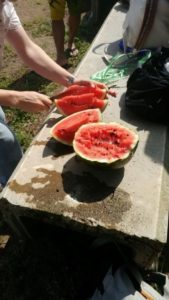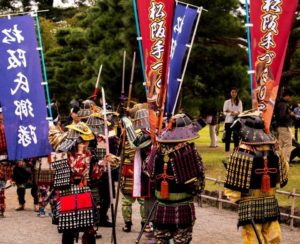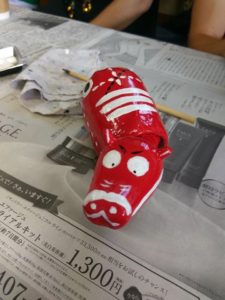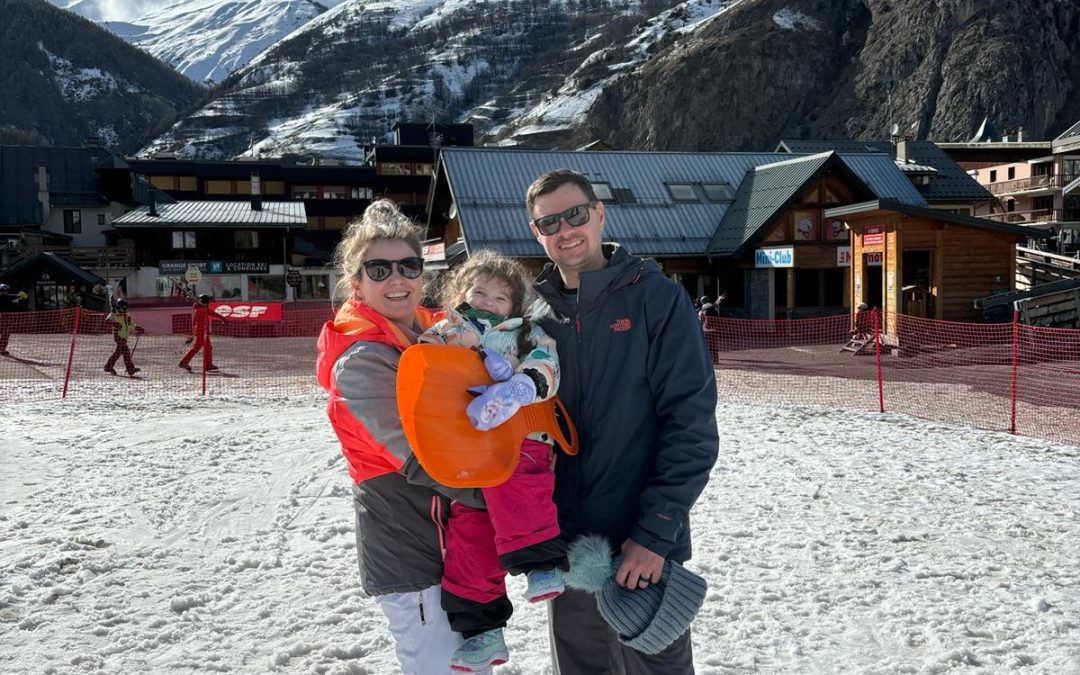September in Japan
September came and went like every other month. It was a busy month, but by far the best so far. We visited Lake Inawashiro, climbed Mount Bandai, attended the Samurai Festival in Aizuwakamatsu and went canyoning in Gunma.
Lake Inawashiro
Lake Inawashiro is located near the village of Inawashiro and the towns of Aizuwakamatsu and Minami Aizu. The lake is the fourth largest in Japan and is centrally located in the prefecture. It is also known as Lake Tenkyo or the heaven’s mirror. The picturesque lake’s surface reflects Mount Bandai that towers over it – hence the name of heaven’s mirror.

Joost, Toby, Abbie, the Benson couple and I decided to spend the day at the lake. We split between the two cars (Abbie and Joost both have cars), bought some food at the nearest Konbini and hit the trail.
It was an hour’s drive to the lake but it was early and we had all day long. At the lake there were lots of people! It was summer and everyone was swimming, preparing food and enjoying themselves. It was hot, windy and cramped, but it was almost as if we were at the beach and we wanted to make the best of the day. Our first activity was a boat trip on the lake. The boat was in the form of a white swan because the swans go there in winter.
The cost of the ride was about 1 000 yen per person – maybe less; I can’t remember right now. The boat cruised from one side of the lake to the other and back again. We had lunch and went outside to take pictures of the lake. It was chilly and windy but incredibly beautiful on the water.
After the boat trip, we decided to go for a stroll on the sandbanks. David and Angela brought a watermelon (they bought it cheaply somewhere in Iizaka where they live) and we decided that it was time to break it open. We found a big rock to put our bags on and David began to open the watermelon like a caveman, initiating endless jokes and funnies. We made the people next to us laugh as well and they offered us a decent knife. They also invited us to join them for lunch and soon we became friends. We went swimming and jet-skiing with them.

At the end of the day we returned to Koriyama station where we had dinner before we all went in different directions. Joost lives in Koriyama, so he knows all the places. He took us to Krispa, a Nepalese restaurant, and with a variety of foods the wonderful, exhausting day came to an end.

Mount Bandai with Toby
Mount Bandai (磐 梯 山, Bandaisan) is a dormant volcano with a height of 1 816 meters. It towers above Aizuwakamatsu, a city in the west of the Fukushima Prefecture, and is one of 100 well-known mountains in Japan. It can be viewed in several ways, including by driving up the mountain on the Bandaisan Gold Line, a toll road. Due to its beautiful colours, Mount Bandai is a very popular place in autumn.
Toby and I didn’t go mountaineering in autumn, but at the end of summer, one day before a typhoon hit the area! We both overestimated our fitness and soon realised the mountain was not friendly with people who aren’t regular mountaineers! We quickly learned that the mountain is very beautiful, but also very dangerous if you’re not careful.

Toby oversaw the route and unconsciously chose the second toughest trail, as we only discovered later when friends who had climbed there before told us so. The first hour was the worst for me. It’s very steep and everywhere there were loose stones; if you’re not careful, you can slide and hurt yourself. To give you an idea of how steep the hiking trails are – they are quite comfortable during the summer, but in winter they’re used as ski trails for tourists! After the first hour we stoped to view the landscape behind us. It was breath-taking. We had a view of the entire Lake Inawashiro as well as parts of Aizuwakamatsu.
The route requires proper walking shoes – a lesson that Toby had to learn with great pain. But we made it and had lunch at the summit – some water, fruit and jelly sweets. Soon we were ready for the rest of the climb. We chatted with the locals and regular mountaineers and enjoyed the most beautiful view until the clouds rolled in after 10 minutes.
There isn’t much more to say about the route except that one must take enough water – it’s not even negotiable. The total climb took us just under six and a half hours – apparently not too bad! I will definitely do it again and would 100% recommend it to anyone.

The view over Goshikinuma, the five coloured lakes, is visible from 600 meters upwards. It is one of the places I still want to visit.
After 10 minutes the summit was completely covered by clouds and it was extremely cold! Is was so glad that I packed a jacket.

Toby and me on the summit, tired but satisfied!
Aizuwakamatsu Samurai Festival (22-24 September 2017)
Aizuwakamatsu in the western half of Fukushima Prefecture is famous for its beautiful castle, rich history and samurai. On 22 September I took the train from my hometown, Shirakawa, to the big city of Koriyama. There I hopped on a train to Aizuwakamatsu to visit my friend, Abbie, for the weekend. Coincidentally, it was Aizu’s biggest festival that weekend too.

Aizu is well-known in the prefecture for the vast number of tourists who visit all the historic buildings, the most famous of which is the Tsuruga Castle. It is built in an impressive park near a traditional Japanese tea house, Rinkaku Tea Cottage. One can enjoy green tea and cake in a breath-taking garden while forgetting about the rest of the world.
The Tsuruga Castle was originally built in 1384, but was burnt down in 1868 during a rebellion against the Meiji government. It was rebuilt in 1965 and nowadays it is a museum with exhibitions on the history of the area, such as the Meiji era (1868-1912) and the Edo era (1603-1867), beautiful kimonos and katana swords. There are also many pictures of locals.

Before Abbie and I could fully enjoy the festival, we picked up a bunch of keys and like Good Samaritans we handed them in at the koban (police). In our broken Japanese, we tried to explain to the policemen that we did not want it back, we just wanted to hand it in. What a bother! Paperwork and more paperwork and eventually, after an hour’s trouble (and a little help from people we had to call because they could speak Japanese) we could enjoy the day. But first we rewarded ourselves with ice cream for our honourable deeds.

Soon we joined the rest of the group. They were (along with an English tour guide!) on tour through the castle to learn about Aizu and the castle’s history. We only stayed with them for a while; Abbie and I had other plans for the afternoon. But it was nice to see everyone. In any case, we would run across each other again through the course of the weekend.

Aizu’s Samurai Festival continued all Saturday. Several floats and groups paraded in the streets and entertained the crowd that encouraged them. People were dressed in traditional kimonos and yukatas that indicate their origins and history. There were several shows around the city. Teiko drums played at the castle and people entertained the children and the older crowd in their traditional clothes. There were lots of hawkers and stalls with typical festive foods and everyone enjoyed the day. The parade’s destination was the castle where the crowd could watch the last scene. Everyone who participated in the parade during the day was also available for pictures with the spectators.
On Sunday we are all gathered for breakfast. Then we visited the temple on a hill called Iiomoriyama where a group of boys who participated in the Boshin war committed suicide. Nowadays it is regarded as a sacred and historical place, and through the course of the day we learned a lot about the history. In 1868, about 20 boys saw a fire in the city. They thought their castle was burning and they were too few to conquer the enemy. They then decided on hara-kiri or seppuku (a kind of suicide pact). They would rather take their own lives than live with the enemy. Only one of the 20 boys survived, and a temple was erected in honour of those who died – the act is regarded as an example of loyalty to this day.
This weekend I definitely recommend to anyone visiting Japan in September!
Gunma Minakami canyoning
FuJet is an organisation that supports the JETs in Fukushima. They regularly arrange events in which the JETs in the prefecture can participate and see each other regularly. These opportunities help us to make friends and build relationships. In September 2017, they organised a canyoning excursion for the JETs in the prefecture. The Minakami canyoning excursion is a fantastic opportunity every year to look forward to. A limited number of places are available and you have to hurry to book a place on the day that the applications open!
On Friday night 29 September we all departed by bus to Gunma Prefecture. Nobody slept on the bus. We just had one big party to entertain ourselves and let the time pass.
We arrived in Gunma in the early hours of the morning and were divided into rooms. We were exhausted and soon fell asleep. The next day would be very busy and we had to be prepared.
For the canyoning we were divided into two groups that would tackle the icy river water of Minakami. I was in the latter group with fewer people, which was ideal for me. We went through narrow spaces, jumped from a 20-meter-high waterfall, made smaller jumps that pumped the adrenaline and swam in the river. The event lasted about two hours.
It was incredibly cold but at the same time incredibly enjoyable. We learned about water safety in a whole new way. The river is not a swimming pool in your backyard.
For the afternoon session, we were once again divided into groups. I participated in river rafting. I enjoyed it, but it was also a little disappointing as the water levels were very low.
We were a group of six and our tour guide. We first had to learn how to jump and move on the raft so that it did not overturn, and we had to be sure of the safety precautions. I don’t have much more to say about river rafting except that it is a wonderful experience and I would like to do it again, but with a little more water in the river!

The evening, when everyone was out of the icy water and warmly dressed, we went to a music festival with English and Japanese singers. After a 10-minute walk to the food stalls all the JETs attacked the food like hungry wolves.

The best part of the evening was when Cormac and I discovered a hot-air balloon! I’ve been in a hot-air balloon before at Hartebeespoort, but Cormac has never been and he dearly wanted to go. I decided to go with him and watch everyone from the top. We enjoyed it very much although it was bitterly cold!
The Gunma excursion I would highly recommend to anyone on the program. The canyon’s program runs right through the year and there is something for each season.
Also read: Email from abroad: Adventures in Japan – Part three
























